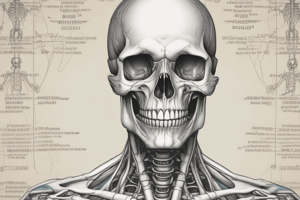Podcast
Questions and Answers
What is the main function of bones in the skeletal system?
What is the main function of bones in the skeletal system?
- Storing essential minerals like calcium and phosphate
- Allowing for movement through contraction
- Producing hormones for blood regulation
- Providing structural support and maintaining body shape (correct)
Which condition results from a deficiency in vitamin D or phosphate during childhood?
Which condition results from a deficiency in vitamin D or phosphate during childhood?
- Osteomyelitis
- Osteoporosis
- Rickets (correct)
- Osteoarthritis
How do bones and muscles work together in enabling movement in the body?
How do bones and muscles work together in enabling movement in the body?
- Muscles store essential minerals for contraction
- Bones provide force through contraction
- Muscles form levers for movement
- Bones form levers while muscles provide the force (correct)
Which type of bone is characterized as being porous and spongy?
Which type of bone is characterized as being porous and spongy?
What is the fundamental role of the skeletal system in the human body?
What is the fundamental role of the skeletal system in the human body?
Flashcards are hidden until you start studying
Study Notes
The Skeletal System: A Framework for Life
The skeletal system, composed of bones, joints, and cartilage, plays a fundamental role in our bodies. It serves as the foundation for our structure, provides protection for vital organs, and enables movement. Here, we'll explore the intricacies of bone structure and the essential functions of the skeletal system.
Bone Structure
Bones are living, dynamic tissues that undergo constant remodeling throughout our lives. They're primarily composed of three types of cells:
- Osteocytes: These cells form the bulk of living bone tissue and play crucial roles in maintaining bone strength and integrity.
- Osteoblasts: These cells synthesize bone tissue and help to regulate bone growth and remodeling.
- Osteoclasts: These cells break down bone tissue and are responsible for bone resorption, which helps to maintain bone mass and shape.
Bones are characterized by their unique structure, which consists of the following components:
- Compact bone: Also called cortical bone, this outer layer of bone is dense and strong, providing structural support and protection.
- Trabecular bone: Also known as cancellous bone, this inner layer of bone is porous and spongy. It provides strength and support while also serving as a reservoir for minerals.
- Bone marrow: Found within the cavities of certain bones, bone marrow is responsible for producing blood cells.
Skeletal System Functions
The skeletal system performs numerous essential functions that are vital to our overall health and well-being.
- Structural support: Bones provide a rigid framework that maintains the body's shape and supports its weight.
- Protection: They protect vital organs such as the brain, heart, and lungs.
- Movement: Bones, joints, and muscles work together to enable movement. Bones form the levers, while muscles provide the force necessary for movement through contraction.
- Hematopoiesis: Bone marrow produces blood cells, which include red blood cells, white blood cells, and platelets.
- Storage: Bones can store calcium and phosphate, which are essential minerals for numerous biological processes.
- Endocrine functions: Bones produce hormones such as parathyroid hormone (PTH), which regulates blood calcium levels.
Joints and Mobility
Joints connect bones and allow them to move and function together. There are two main types of joints:
- Fibrous joints: These joints are held together by fibrous connective tissue and allow minimal movement. Examples include the sutures in the skull and the intervertebral discs between the vertebrae.
- Syndesmoses and synovial joints: These joints are connected by ligaments and allow a greater range of motion. Examples include the elbow and knee joints.
Synovial joints, in particular, contain a synovial membrane that produces synovial fluid, which lubricates the joint and reduces friction during movement.
Bone Conditions and Diseases
Several conditions and diseases can affect the skeletal system. Some examples include:
- Osteoporosis: This condition causes bones to become weak and brittle, increasing the risk of fractures.
- Osteoarthritis: This degenerative joint disease causes the cartilage in joints to break down, leading to pain and limited mobility.
- Rickets: This childhood disease results from a deficiency in vitamin D or phosphate, causing bones to become soft and misshapen.
- Osteomyelitis: This bone infection can lead to severe pain and, if left untreated, can result in long-term complications or amputation.
Conclusion
The skeletal system is a complex and vital network of bones, joints, and cartilage that provides our bodies with structure, protection, and movement. Understanding the role of each component and its function can help us maintain good health and prevent diseases affecting the skeletal system.
References:
- Not applicable (Markdown format does not support citations)
Studying That Suits You
Use AI to generate personalized quizzes and flashcards to suit your learning preferences.




